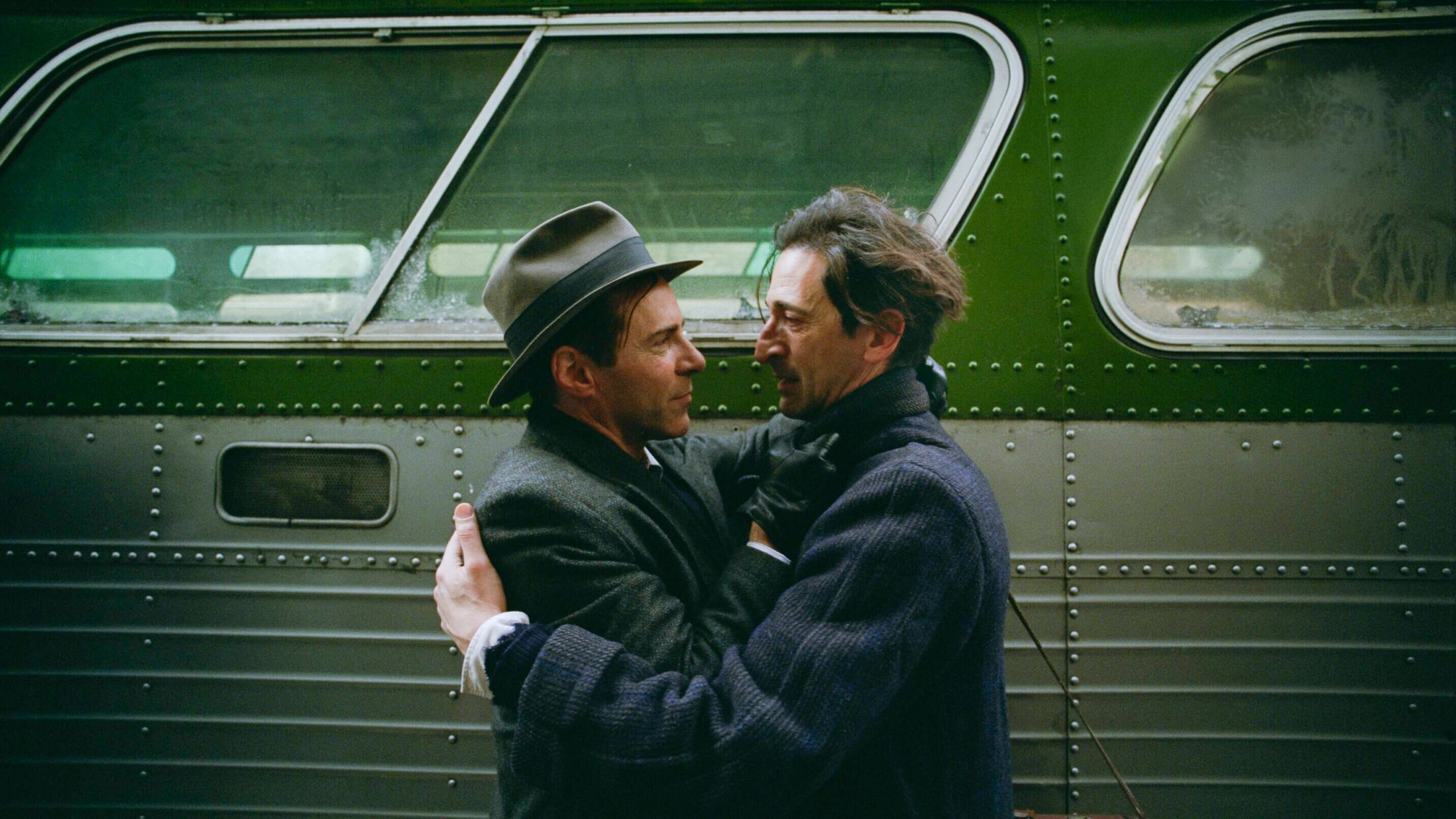THE BRUTALIST
If fictional biopics of “great men” have trained us to look for a “Rosebud” needle in the haystack, then The Brutalist poses a reframed question. Can you piece together gnarled genius by the angles of the haystack’s massive facade? Nearly four hours long with a theatrical intermission and shot on long-dormant Vista Vision film to approximate the widescreen majesty of 70mm, this epic sketches a decade in the life of László Toth (Adrien Brody). The fictional Bauhaus-trained architect fled war-torn Hungary looking to reestablish himself in 1950s Philadelphia while awaiting reunification with his wife (Felicity Jones). Immediately, Toth’s brush with the American dream manifests as blind luck and terrible misfortune clasping hands. He soon falls into the employ of Harrison Lee Van Buren (Guy Pearce), a Vanderbiltian tycoon with a volatile appreciation for Toth’s architecture and company. All at once, Toth and Van Buren’s relationship is the funniest and darkest part of The Brutalist (László is deep; Harrison is not), a clear allegory for how deep-pocketed benefactors can torture artists as ambitious as Toth—and Brutalist director Brady Corbet—with golden handcuffs. Fittingly, though, The Brutalist isn’t a movie about a mid-century modernist obsessed with spare elegance and clean lines. László pours the enormous agony of living into his monoliths, and by god, Corbet has designed his own here. R. CHANCE SOLEM-PFEIFER. Cinema 21, Hollywood Theatre, Regal Lloyd Center.
BETTER MAN
Better Man answers two questions: who is Robbie Williams, and why is he a monkey in his biopic? The British pop singer tells us it’s to represent how he sees himself as a person and entertainer. With that lore established, Better Man takes viewers on a surreal ride of Williams’ fame story from childhood through his boy band days with Take That, finally launching into the rise and fall of his solo career as he landed number-one songs in the U.K. and established loyal fanbases overseas. Better Man’s surprisingly high $110 million budget gets fully utilized throughout high energy musical dance numbers, Planet of the Apes-caliber technology that transformed Williams (Jonno Davies) into a believable primate, and a well-written script full of vulnerability and enough uncomfortable truths about Williams’ past to not feel like a full vanity project. The most compelling part of the film comes from the chimp-as-a-metaphor for the mental illness that fueled Williams' escalating substance abuse issues and self-destructive tendencies. Some scenes are surprisingly graphic, but powerfully imaginative nonetheless. Chimp Williams almost invalidates the captivating portrayal of intrusive negative thoughts, but the way these versions of himself appear really embody what it feels like to be at war with oneself. R. JAGGER BLAEC. Studio One Theaters, AMC, Cinemark and Regal locations.
THE DAMNED
Cinematographer Eli Arenson captures the Icelandic coast for director Thordur Palsson’s 19th century supernatural horror The Damned with such clarity that bones could ache from the bitter cold of the Arctic winter’s unforgiving terrain. Eva (Odessa Young)’s remote fishing outpost, inherited from her husband, has suffered a lean season and is snowed in from the rest of the world. Eva and her crew notice a large sailing shipwreck near the shore, but decide not to intervene since they reason they can’t support survivors. A series of tragic events unfold after the survivors’ audible cries for help are ignored, and some suspect the curse of a draugr—an Arctic revenant from Icelandic and Nordic folklore bent on revenge. The Damned will draw viewers in as the fishers try to survive Iceland’s natural beauty. Body language and linguistic differences factor heavily into building The Damned’s relentless tension. Seeing Young lead the story as a woman amongst a group of 19th century men was believable and refreshing. Her determination to solve the mystery with as many of her crew making it out alive keeps viewers warm in a chilling thriller. R. RUDY VALDEZ. Cinemark and Regal locations.
THE LAST SHOWGIRL
Pamela Anderson’s performance in The Last Showgirl should come as little surprise. Just ask anyone who watched her in the criminally underseen Barb Wire or in her TV work. The shock is how it took so long for someone—in this case, director Gia Coppola (granddaughter of Francis Ford)—to recognize her skills and make good use of them. The 57-year-old actor stars as Shelly, one of the women dancing in an old-school Las Vegas revue on the verge of shutting down for good. Having stuck with the show for three decades, her prospects are limited and her future is a frightening question mark. Anderson presents all of this with wide, terrified eyes and furtive, almost manic movements. It’s a stunning, heartbreaking performance made even more so by the able support she receives from Kiernan Shipka and Brenda Song as two younger dancers, and Jamie Lee Curtis playing Shelly’s equally broken best friend. Coppola and screenwriter Kate Gersten do lay on thick the themes of folks in middle age struggling to keep up with the churn of modern life, especially women who are often dismissed out of hand when they cease being hot in society’s eyes, but that doesn’t make them any less effective. R. ROBERT HAM. Living Room Theaters, Cinemark and Regal locations.

